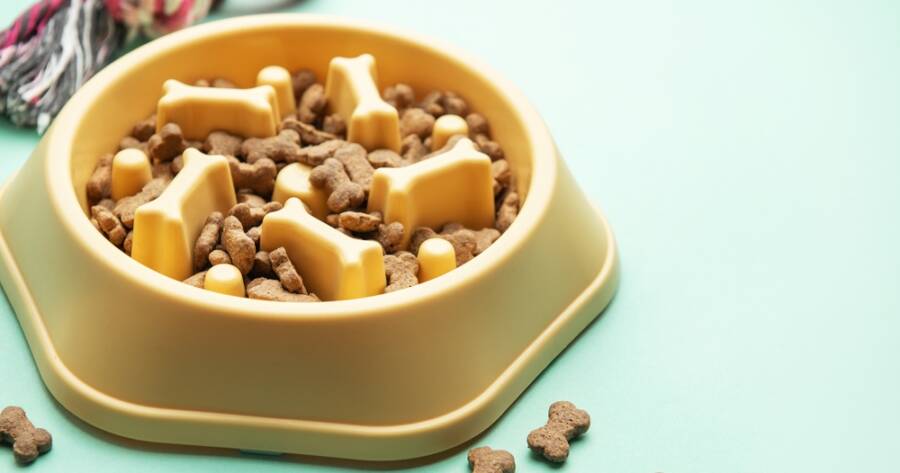If your dog gulps down food in seconds, you’re not alone. Many dogs eat too fast, which can lead to digestive problems, bloating, and even serious health risks. Fast eating doesn’t give a dog’s body time to properly process food, which can cause discomfort and poor nutrient absorption. That’s where slow feeder bowls come in. Designed with ridges or patterns that make eating more challenging, slow feeding bowls can help your dog eat at a healthier pace and enjoy mealtimes more mindfully.
Why Eating Too Fast Is a Problem
When dogs eat quickly, they often swallow large amounts of air along with their food. This can lead to bloating, also known as gastric dilatation-volvulus (GDV), which is a potentially life-threatening condition. Although not all cases of fast eating cause GDV, even mild bloating or indigestion can make your dog uncomfortable and lethargic.
Fast eating can also cause dogs to choke, vomit, or experience gastrointestinal distress. Their stomachs don’t get enough time to signal the brain that they’re full, which may lead to overeating. Long-term, this pattern can result in weight gain and related health issues, such as joint problems and fatigue.
Slow feeder bowls are a simple way to help prevent these problems by slowing your dog down during meals.
How Slow Feeder Bowls Work
Slow feeder bowls are typically made with raised ridges, spirals, or maze-like patterns that create obstacles. These barriers force your dog to work a little harder to reach each bite, encouraging smaller mouthfuls and more chewing.
The physical design of these bowls naturally reduces the speed at which food is consumed. Instead of inhaling their meals in one or two gulps, dogs must navigate the shapes and channels with their tongues or snouts. This slows the process and makes mealtime more of a mental challenge, which can also provide added enrichment.
The goal isn’t to frustrate your dog but to gently encourage slower, more thoughtful eating habits—something that benefits both their physical and emotional well-being.
Benefits for Digestion and Overall Health
One of the biggest benefits of slow feeder bowls is improved digestion. When dogs eat slowly, they chew more thoroughly and produce more saliva, which begins breaking down food before it even reaches the stomach. This makes it easier for the digestive system to do its job, reducing the risk of upset stomachs or poorly digested meals.
Eating at a slower pace also gives the stomach time to release hormones that signal fullness. Dogs that take longer to eat are less likely to overeat, which can help maintain a healthy weight. This is especially helpful for breeds prone to obesity or dogs that are highly food-driven.
Reducing bloating is another key benefit. When dogs swallow less air with their food, they experience fewer symptoms like gas, burping, or stomach swelling. While a slow feeder may not completely eliminate the risk of bloat, it significantly lowers the chances by addressing one of the major triggers—rapid eating.
Added Enrichment and Mental Stimulation
Slow feeders don’t just help the body—they also benefit the brain. Many dogs, especially high-energy breeds, need mental stimulation to stay happy and avoid boredom. Mealtime can become a fun puzzle rather than just a routine task.
The process of navigating the ridges or patterns in a slow feeder bowl can satisfy a dog’s natural instincts to problem-solve and forage. This is especially helpful for dogs who eat the same kibble every day and may lack variety or challenge in their daily routines.
Using a slow feeder can also reduce behaviors like begging or pacing after meals because the dog feels more engaged and satisfied. For anxious or food-obsessed dogs, this can create a more peaceful post-meal experience.
Choosing the Right Bowl for Your Dog
Not all slow feeder bowls are created equal, and it’s important to pick one that suits your dog’s size, breed, and eating style. Larger dogs may need deeper bowls with wider spacing, while smaller dogs or flat-faced breeds may do better with shallow patterns.
Material matters, too. Bowls come in plastic, stainless steel, or silicone. If your dog likes to chew or tends to be rough with their bowl, a more durable option like stainless steel may be best. Always supervise mealtimes when trying a new bowl to ensure your dog is adapting well to the change.
You can also try homemade slow feeders by placing a clean ball or toy in their regular bowl to create a simple obstacle. However, commercial slow feeders are often safer and more effective in the long run.
A Simple Change for a Healthier Pup
Helping your dog eat more slowly doesn’t have to be complicated. With a slow feeder bowl, you can support better digestion, reduce the risk of bloating, and even improve your dog’s overall mood and behavior. This small change turns every meal into an opportunity to build healthier habits.
Whether your dog is young or old, playful or anxious, eating at a calmer pace can make a big difference in their quality of life. So slow things down—and let your pup enjoy every bite.

